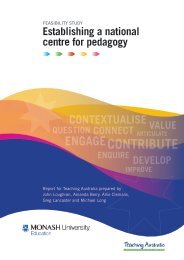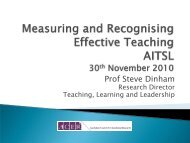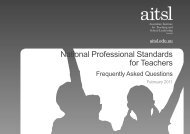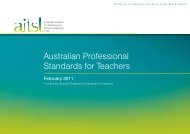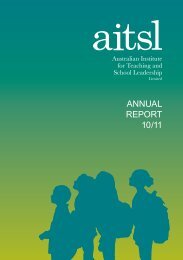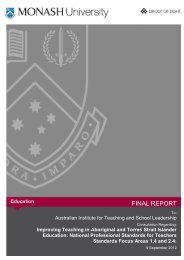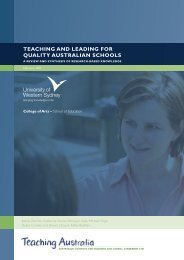Even when innovation is successful, it is difficult to sustain. Giles and Hargreaves’ (2006) longitudinalstudies of innovative schools identified three common forces behind their eventual decline: envyand anxiety from competing institutions in the surrounding system, the evolutionary process of agingand decline in the organisational life cycle, and the regressive effects of large-scale, standardisedreform strategies. Their recommended solution was to promote the concept of schools as learningorganisations which they argued could ameliorate the effects of these forces.A number of authors have distinguished three key dimensions of barriers to change (Anderson 1996;Hall 1997; House 1981; Johnson 2007). The technical dimension relates to professional knowledge andskills and their acquisition, as well as classroom management issues, time for planning and professionallearning provision. In Hall’s view (1997, p. 343), it is ‘founded on production, task orientation, efficiency,and a mechanistic view of innovation’. The political dimension relates to power and influence, includingadministrative support and leadership, collaboration, and the negotiation and resolution of conflict. Thecultural dimension includes values, beliefs and norms, both consensual and competing in individuals,groups and organisations.Given these analyses, leading effective and sustainable curriculum change must be seen as a complexand difficult task and a challenge to the work of curriculum leaders. The range and dynamic nature offactors to be considered suggest a need for strategies to address complexity, most readily found inliterature on systems thinking (Dawidowicz 2009; Dyehouse 2010) and strategic leadership (Preedy,Glatter and Wise 2003).Given the role of the teacher in interpreting and implementing the curriculum, the importance of theteacher in curriculum reform has long been argued (Elliott 1994). This was the rationale for the teacherledapproach to curriculum innovation and development, which acknowledged that the curriculumthat matters most is the one enacted by teachers and experienced by students. Recent researchhas highlighted the ways in which teachers’ involvement in innovation involves personal, social andemotional responses to change which influence their commitment (Zembylas and Barker 2007).However, McCulloch points out that the early hopes for teacher-led curriculum reform underestimatedthe constraints of their environments (McCulloch 1998). Anderson (2004, p. 109) identifies three‘understandable’ reasons for teachers’ reluctance to change: a lack of awareness that change isneeded; a lack of knowledge, particularly procedural knowledge, concerning how to change; and thebelief that changes will not make any difference to them or their students.The challenges of curriculum change are not to be underestimated, but a considerable research efforthas recently been applied to enhance the prospects of change. This work has identified a number ofimportant strategies which can improve the process of curriculum change.Factors which promote curriculum changeIn their research into factors influencing the transfer of good educational practice Fielding et al. (2005)identified four elements of practice transfer that were of special significance, all relating to teacherslearning with and from each other over periods of time. Most important was that teacher learning isa social process sustained by relationships and trust. In addition, it is a personal and interpersonalprocess that has to engage with teachers’ individual and institutional identity, and which requires supportfor learner engagement by fostering the willingness to try something out; and, lastly, that the work oftransfer has to be sustained over time to a greater extent than is commonly done.Hall’s (1997) study examined the relationships between curriculum change and the practices ofknowledge used by teachers. He found that there was a significant association between teachers’ useof assistance and information and more enriched curriculum implementation, and between a capacitybuildingorientation to knowledge use (becoming more self-sufficient and less reliant on externalassistance) and greater teacher autonomy and control over the implementation. In other words,teachers become more independent in curriculum innovation the wider and more intensive their use ofinformation, a finding which has clear implications for professional learning.5 <strong>Professional</strong> <strong>Learning</strong> <strong>Flagship</strong> <strong>Program</strong>: <strong>Leading</strong> <strong>Curriculum</strong> <strong>Change</strong>: Literature Review
This emphasis on capacity-building is endorsed by Levin and Fullan in their review of effectivechange and large-scale reform. While change is complex, they identify capacity-building as the mostimportant single element of successful change strategies, defining capacity-building as ‘any strategythat increases the collective effectiveness of a group’ (Levin and Fullan 2008, p. 295). This involvesdeveloping individual and collective knowledge and competencies, resources and motivation: ‘nothinglasting will happen unless people develop new capacities. At the same time, new capacities buildmotivation because they generate clarity, skills and success’ (Levin and Fullan 2008, p. 295). They pointout that capacity-building ‘is not about one way transmission of knowledge’ but requires ‘learning incontext ... creating cultures where learning in context is endemic’ (p. 296), quoting Elmore:Cultures do not change by mandate; they change by the specific displacement of existing norms,structures, and processes by others; the process of cultural change depends fundamentally onmodeling the new values and behavior that you expect to displace the existing ones.(Elmore 2004, p. 11)At a more concrete level, and particularly relevant in the context of professional learning, is theConcerns-Based Adoption Model which acknowledges that learning brings change, and that critical toensuring that learning ‘takes hold’ is the need to support people through the process of change (Loucks-Horsley 1996). The model claims that people considering and experiencing change evolve in the kindsof questions they ask and how they deal with the change. Early questions tend to be self-oriented: ‘Whatis it? How will it affect me?’ Later questions are more task-oriented: ‘How do I do it? How can I use thesematerials efficiently? How can I organise myself? Why is it taking so much time?’ Finally, if self and taskconcerns can be resolved, the individual can focus on impact by asking: ‘Is this change working forstudents? Is there something that will work even better?’ <strong>Leading</strong> change requires an appreciation ofthis developmental sequence and the ability to respond to it.Owston (2007) reviewed the literature on educational innovation for his study of the sustained use ofeducational technology in 59 schools, and identified three contextual levels that affect and mediatechange. The micro-level comprises such factors as classroom organisation and personal characteristicsof the teachers and students. The meso-level includes the school organisation and culture and therole of administrators, parents and community leaders. The macro-level encompasses the previoustwo levels, and concerns state and national policies and international trends which might influencecurriculum and assessment, professional development, and telecommunications. Owston (2007, p. 73)concluded that:The foremost essential requirement for sustainability in the model is teacher support of theinnovation. Support from the school principal and students is also essential, as is the need forteachers to perceive the innovation to be of value and for teacher professional development.Priestley (2011) offers a theoretical framework for understanding educational change based on Archer’smorphogenetic approach (Archer 1988, 1995, 2000), arguing that it is an important improvement onthe simplistic notions of the linear implementation of monolithic policy which have been widely critiqued(Cuban, 1998). Priestley (2011 p. 6) argues that ‘policymakers and practitioners need to be more explicitin differentiating between innovation—the policies, ideas, and texts that promote and articulate changesin practice—and actual changes in social practice that may occur following a particular innovation’.This then accentuates the need for ‘the building of professional capacity to engage with policy, boostingthe ability of teachers to respond creatively from a wide repertoire for maneuver ... to the problemsfaced when engaging with innovation’ (p. 8). Also important is the need to see capacity as more thanan individual quality or ability, and to ensure that ‘all involved in the process of change become awareof structural factors that might enable or constrain agency including school systems, the demands ofattainment and quality assurance, relationships and power structures within schools, available artifacts,and the physical layout of buildings’ (p. 8). Finally, such an approach recommends an understanding ofcultural considerations such as the values and attitudes that limit or promote agency and the access thatpractitioners have to alternative cultural resources.From this framework, Priestley (2011) developed a research strategy for studying change which focusedon three sets of questions dealing with culture and the kinds of knowledge which inform everyday<strong>Professional</strong> <strong>Learning</strong> <strong>Flagship</strong> <strong>Program</strong>: <strong>Leading</strong> <strong>Curriculum</strong> <strong>Change</strong>: Literature Review 6
- Page 1 and 2: Professional Learning FlagshipProgr
- Page 3 and 4: ContentsIntroduction ..............
- Page 5 and 6: Curriculum change: Implications for
- Page 7: Table 1: Overview of factors affect
- Page 11 and 12: Much of the foregoing discussion is
- Page 13 and 14: Features of successful professional
- Page 16 and 17: p. 1051) conclude that, ‘Findings
- Page 18 and 19: 2007; Gruenert 2005; Printy 2008; S
- Page 20 and 21: RecommendationsProfessional learnin
- Page 22 and 23: impersonal relationships• rationa
- Page 24 and 25: • The organisational goals are di
- Page 26 and 27: Table 2: Two views of teacher leade
- Page 28 and 29: A range of specifications and stand
- Page 30 and 31: In secondary schools, teacher leade
- Page 32 and 33: 1. Stimulus for innovation — Why
- Page 34 and 35: Table 4: Elements and processes of
- Page 36 and 37: The education of Indigenous student
- Page 38 and 39: ReferencesAinscow, M. (2005). Devel
- Page 40 and 41: Daly, A. J. (2009). Rigid Response
- Page 42 and 43: Hall, R. (1997). Knowledge Use and
- Page 44 and 45: Meirink, J., Meijer, P., Verloop, N
- Page 46 and 47: Thorpe, R., and Gold, J. (2010). Le
- Page 48: aitsl.edu.auFurther informationTele




